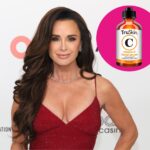Monster Energy drinks are a popular choice for those needing an energy boost, but how much caffeine do they really contain? With various flavors and product lines, the caffeine content can differ significantly. This guide breaks down the caffeine levels in Monster Energy drinks, compares them to coffee and other energy drinks, and explores the potential health implications.
Caffeine Content in Monster Energy Drinks
Monster Energy offers a wide array of drinks, each with a distinct caffeine dosage. Knowing how much caffeine you’re consuming is crucial.
Here’s a look at the caffeine content in some popular Monster Energy drinks:
Image showing a table summarizing the caffeine content of different Monster Energy drinks.
Other Active Ingredients in Monster Energy
Besides caffeine, Monster Energy drinks contain other active ingredients:
- Taurine: An amino acid naturally present in the body, aiding in electrolyte balance and endurance.
- Inositol: Found in foods and produced by the body, assisting with metabolism, insulin function, and energy conversion.
- L-Carnitine: A compound that helps convert fat into energy.
- B Vitamins: Essential for cell function and metabolism.
While these ingredients might seem beneficial, dieticians suggest that their concentrated levels, when combined with caffeine, could be more potent than naturally occurring sources. This combination can affect arterial function, potentially inhibiting proper dilation [1].
Monster drinks are generally not recommended for pregnant or nursing women, children, or individuals sensitive to caffeine.
Caffeine Comparison: Monster vs. Coffee
A typical 8 oz cup of coffee contains around 100 milligrams of caffeine, but this can vary based on factors like bean type, brewing method, and coffee-to-water ratio. An espresso shot typically has 75 mg, while a 4 oz cup of Vietnamese coffee can contain up to 130 mg of caffeine.
Factors influencing caffeine content in coffee:
- High coffee-to-water ratio
- Use of dark roast robusta beans
- Specific brewing method
Even a strong cup of Vietnamese coffee often contains less caffeine than an original Monster Energy drink.
Here’s a comparison of caffeine content in Monster vs. various coffee types:
| Type of coffee | Size of cup | Caffeine per serving |
|---|---|---|
| Vietnamese coffee | 2-4 oz | 66-130 mg |
| Espresso coffee (single shot) | 1-2 shots | 75-150 mg |
| Pour-over | 8 oz | 90-160 mg |
| Cold brew | 16 oz | 197-213 mg |
| French press | 8 oz | 100-137 mg |
| Drip coffee | 8 oz | 65-120 mg |
| Instant coffee | 8 oz | 80-120 mg |
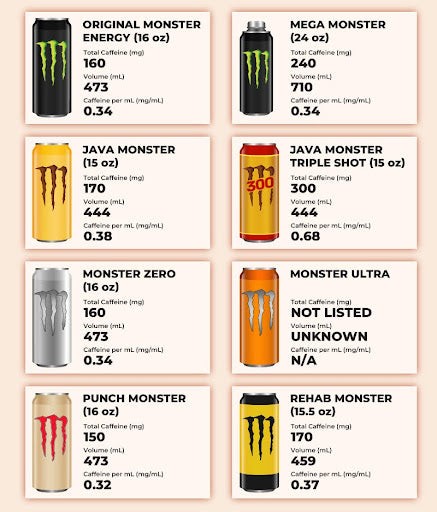
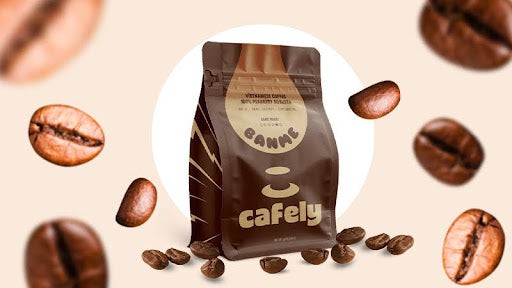
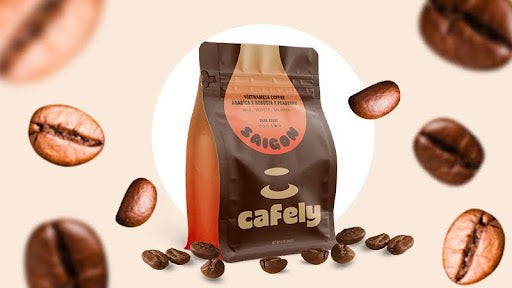
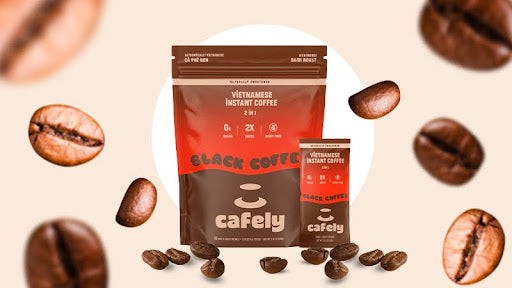
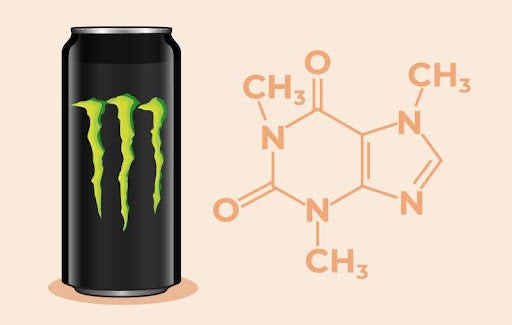
Stronger Coffee Alternatives to Monster Energy Drinks
If you’re seeking a caffeine boost but prefer a potentially safer option like coffee, there are alternatives.
Reasons to choose coffee over energy drinks:
- Natural, plant-derived source
- Contains vitamins, antioxidants, and nutrients [2]
- Free from added sugars and synthetic compounds (unless added)
1. Cafely BanMe Coffee
Cafely’s BanMe is engineered for strength, boasting 9000 mg of caffeine per bag. It’s crafted from 100% shade-grown peaberry robusta beans.
2. Cafely SaiGon OG Coffee
SaiGon OG offers a full-bodied coffee experience, delivering approximately 120-150 milligrams of caffeine per cup from its robusta, arabica, and peaberry blend. Robusta is stronger than arabica in both flavor and caffeine, and peaberry contains nearly 30% more caffeine than typical robusta.
3. Cafely Instant Coffee Packs
Cafely also offers highly caffeinated instant coffee packs, delivering 150 mg of caffeine in seconds.
Monster Energy vs. Other Energy Drinks
Monster Energy drinks generally fall in the middle range regarding caffeine content compared to other popular energy drinks. Bang contains the highest amount of caffeine at 300 mg per can, while Red Bull has a lower caffeine level at 80 mg.
Comparison of Popular Caffeinated Drinks:
| Drink | Serving Size | Caffeine per Serving | Caffeine Per oz |
|---|---|---|---|
| Bang | 16 fl oz / 473 mL | 300 mg | 18.75 mg / oz |
| Monster | 16 fl oz / 473 mL | 160 mg | 10 mg / oz |
| Red Bull | 8.5 fl oz / 250 mL | 80 mg | 9.6 mg / oz |
| Rockstar | 16 fl oz / 473 mL | 160 mg | 10 mg / oz |
| Regular Coffee | 8 oz / 240 mL | 80–100 mg | 10 mg / oz |
| Decaf Coffee | 8 oz / 240 mL | 0–7 mg | ~1 mg / oz |
| Black Tea | 8 oz / 240 mL | 60 mg | 5 mg / oz |
| Matcha | 8 oz / 240 mL | 100 mg | 12.5 mg/oz |
About the Monster Energy Corporation
Monster Energy is part of the Monster Beverage Corporation, initially founded as Hansen’s in 1935, and renamed in 2012. In the first quarter of 2024, the company reported an 11.8% increase in net sales, reaching $1.90 billion.
The Monster Energy brand held a market share of 29.7 percent in 2023, second only to Red Bull.
Health Implications of Caffeine
Healthy adults can typically consume up to 400 mg of caffeine daily, roughly equivalent to four or five cups of coffee.
Watch out for negative side effects such as jitters, insomnia, anxiety, changes in heart rate, headaches, or stomach upset. These signs indicate that you may need to reduce your caffeine intake.
Factors affecting individual caffeine sensitivity:
- Body weight
- Medications
- Individual sensitivity
- Metabolism rate
Pregnant or breastfeeding women should consult their doctor regarding safe caffeine limits.
Is Caffeine Safe for Children?
The American Academy of Pediatrics advises against caffeine consumption for children and adolescents. Excessive caffeine intake can pose risks, and some studies discourage any dietary caffeine for children [3].
FAQs: Caffeine in Monster Energy
1. How much caffeine is in a standard can of Monster Energy?
The original Monster Energy drink contains 166 milligrams of caffeine per 16-ounce can.
2. Is it safe to drink Monster Energy every day?
It’s best to consume energy drinks in moderation. The FDA recommends adults consume up to 400 mg of caffeine daily.
3. How does the caffeine in Monster compare to a cup of coffee?
The original Monster Energy drink has 166 milligrams of caffeine, while a typical cup of coffee contains around 100 milligrams.
4. Can you experience caffeine withdrawal from Monster?
Yes, caffeine withdrawal is possible, with symptoms ranging from headaches and fatigue to irritability and low mood.
5. What are healthier caffeine alternatives to Monster?
Coffee, black tea, and green tea are generally healthier alternatives.
6. Does Monster Energy contain natural or synthetic caffeine?
Monster Energy may contain synthetic caffeine due to its manufacturing process and added ingredients.
7. What are the effects of Monster Energy on long-term health?
Long-term consumption of Monster Energy drinks could be harmful due to high caffeine levels, added sugars, and artificial additives.
8. How long does the caffeine effect from a Monster last?
The caffeine boost from a Monster Energy drink typically lasts for 6-9 hours.
9. Are there any Monster Energy drinks without caffeine?
Currently, there are no zero-caffeine options in the Monster Energy product line.
10. What is the maximum amount of Monster one should drink in a day?
An Original Monster Energy drink contains 166 milligrams of caffeine. The warning on a Monster Energy Zero Ultra can states a maximum of one can every 4 hours, with a limit of 3 cans per day.
References
- Higgins, J. P., Yang, B., Herrin, N. E., Yarlagadda, S., Le, G. T., Ortiz, B. L., … & Infanger, S. C. (2017). Consumption of energy beverages is associated with attenuation of arterial endothelial flow-mediated dilatation. World journal of cardiology, 9(2), 162. https://www.ncbi.nlm.nih.gov/pmc/articles/PMC5329743/
- Liang, N., & Kitts, D. D. (2014). Antioxidant property of coffee components: assessment of methods that define mechanisms of action. Molecules, 19(11), 19180-19208. https://www.mdpi.com/1420-3049/19/11/19180
- Liang, Ningjian and Kitts, David D. (2014). Antioxidant Property of Coffee Components: Assessment of Methods that Define Mechanisms of Action. Vancouver, Canada. University of British Columbia Molecules.10.3390/molecules191119180
